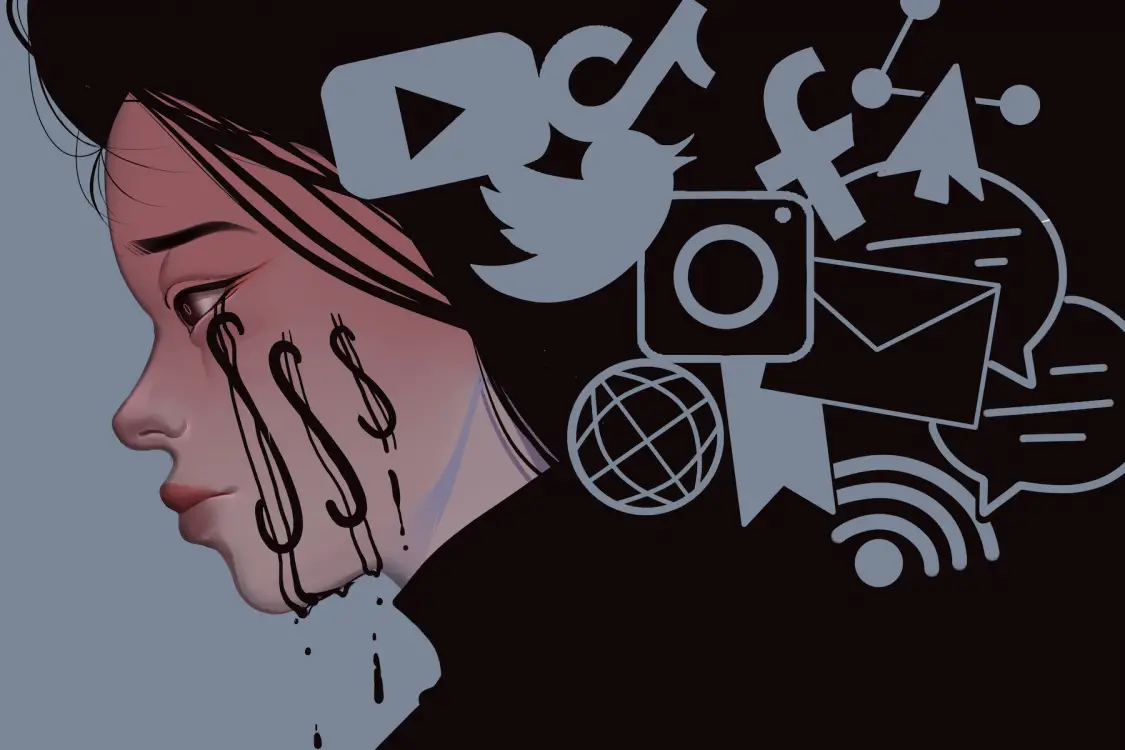In an age where trends die in the blink of an eye and being different equals relevance, the internet has unearthed a dark interest in the nuances of mental illness. From occasional anxiety caused by public speaking to severe schizophrenia, the masses — especially teenagers and young adults — have become obsessed with such diagnoses. Society clamors to be burdened with anything that can prove that their brains don’t work the same as everyone else’s, no matter how unsettling that truth might be.
In a world where everyone online desperately wants to stand out against the endless deluge of trends and viral videos, being mentally ill is the so-called “Golden Ticket.” It can not only make you invincible in the face of “the discourse” but it can also make you appear just deranged enough that you’ll be seen. It makes you shine along with the glare from the screen that’s causing all that rot.
To get to the root of such an unusual phenomenon, it’s important to note its origin. The issue stems from the internet’s ability to not only commodify mental illness but to ensure its spread. The creation of sites like Instagram and Twitter, which quickly became mainstream, correlates with the rise in anxiety levels in teenagers.
Phone separation anxiety (PSA), also known as nomophobia, has become a common malady in the everyday lives of millions. It is characterized by poorer sleep quality, social isolation and even relationship issues.
But it seems that in addition to the addiction that many have to their phones, there are other darker effects of mental illness’s fetishization online. Young girls on TikTok have developed tics from watching many videos associated with Tourette syndrome. The first result that is auto-predicted when you type “eating disorder” into Google is “eating disorders and social media.”
With this evidence in hand, it’s easy to see that in some cases, teenagers intentionally seek diagnoses of anything related to mental illness, from generalized anxiety disorder — which is quite common with over 3 million cases per year in the U.S. — to more severe illnesses, such as borderline personality disorder or bipolar disorder. These teens want to latch onto any sort of symptom they can find that can be used to garner attention.
The main problem with this, besides the ensuing incoherent frenzy that seems to be taking hold of younger populations, is that they don’t understand what these disorders or symptoms actually mean. There are several factors that could be causing this issue. Firstly, terms such as “triggering,” “manic” or “gaslight” have overtaken social media sites, becoming buzzwords that are often used as slang and even appear in memes.
However, despite their trending usage, these words originate from the medical field and are commonly used in cognitive-behavioral therapy or in reference to mental illness diagnoses.
In addition to excessive references to certain mental illnesses — calling someone “bipolar” when they experience mood swings, or saying you have “OCD” when you’re just a perfectionist — these watered-down versions of various medical terms not only disillusion anyone observing their use, but they also diminish the struggles of those who live with these disorders.
Also, by having such vocabulary on hand, it’s easier for teens to victimize themselves and thus immunize themselves against internet attacks, as they can brandish their newfound ailments as an excuse against accountability.
While it’s long been proven that extensive social media exposure has negative effects on the brain and image of self and heightens levels of anxiety and feelings of depression, wanting, or actively desiring any sort of defect or disorder, is a completely different level of damage.
Mental illness has spiraled into a whole new subculture of its own. It’s not just about taking antidepressants or having trouble with public speaking anymore. There are subgenres of music and books for “sad girls,” with figureheads like Slyvia Plath, Sally Rooney, Phoebe Bridgers and Mitski.
There are also aesthetics that come with such a mindset; iced oat milk lattes and tote bags stuffed with crystals. But the bigger picture is that the creation of such an image, one that is seen as “cool” or even “sexy,” is what’s driving these young people to seek out and label themselves with things that don’t apply.
Perhaps this evolution in the outlook on mental illness has come from the fact that people believe being depressed, anxious, or mentally ill inherently makes you more interesting or thoughtful about the world around you. Because surely, no one with a perfectly neurotypical brain could ever have any sort of dimension or depth. In today’s world, mental illness is slowly becoming a rite of passage that teens think that they must endure to have any sort of relevance.
While such a perspective is often hailed as progressive or inclusive, that’s not even the case. These labels of “depression” and “anxiety” are simply worn as medals and turned into personality traits. But those that battle disorders or fight against the more severe symptoms, like schizophrenia-induced hallucinations, and those struggling with empathy or intrusive thoughts, are still demonized.
The internet has turned mental illness into nothing more than a trend and a commodity, mutating it into something that is fashionable or something that makes those who suffer from it more interesting. However, that isn’t the case. Mental illness is a topic that should be approached with delicacy and nuance, as it severely affects so many people’s lives and relationships.
And while the behaviors that flatten the experiences of people suffering from a mental illness, turning them into a culture that should be sought, are alarming, it’s also something we can learn from.
In the ever so expansive void of the internet, it’s easy to believe that the grass is greener on the other side. That other people and what they possess are infinitely more interesting or important. But that is not the case when it comes to mental illness.
The grass isn’t greener over here — everything is dead.

















